|
|
Review PDA Fujitsu Siemens Pocket LOOX 710
Standard kit:
- PDA
- Extra stylus
- USB cable for synchronization plugging USB-devices
- Docking station
- Carrying case
- CD with the software
- Voucher for applications from http://pocketloox-choice.com
- Manual

In essence, the new model Fujitsu Siemens Pocket LOOX 710 is a simplified version of LOOX 720. It has no camera, the screen resolution is less (QVGA instead of VGA, 4 times as little pixels on the screen, - that's the main difference), the diagonal is shorter, there are less memory and MHz, however the battery life is longer and the price is lower. This is a good mid range handheld in the market. Other features are the same as in the senior model. So we'll just copy the part describing the same things from the LOOX 720 review and focus only on differences. Besides soon there will be available the LOOX 718, an exact copy of the LOOX 720 without a camera.

The size of the LOOX 710 is like that of Asus A730, if you don't put them together, you'll hardly see the difference. The device is slightly taller that, for example, HP iPaq 2210, but it is much smaller against Toshiba e800. The handheld lies comfortably in hand, it doesn't slip mostly due to the side grooves in the style of Sony Ericsson t610/630. Given the fact, the LOOX 710 is equipped with two expansion slots; its size is close to the optimum, though the length could be shorter. Compare with other PDAs:
- HP iPaq hx2700: 119x76x16 mm 164 g
- FS Pocket LOOX 710: 122x72x16.1 mm 180 g
- Asus A730: 117.5x72.8x16.9 mm 170 g
- HP iPaq 4150: 113.6x70.6x13.5 mm 133 g
The LOOX 710 weighs 180 g - not a lightweight handheld, but that's typical for the devices with two connectors. Besides a high capacity battery adds greatly to the total weight. I'd mark a peculiarity of the junior model; it's 10 g heavier than the LOOX 720, though there are no reasons for it.
Design and the color solution are typical for the latest PDAs by Fujitsu Siemens: nice dark grey plastic and silver edging, smooth, but strict lines. In all, design leaves very pleasant feelings, the PDA has its own image - stylish, but not flashy. As for design it's hard to be objective, somebody might dislike it. The assembly quality proves to be very high, all details fit perfectly. Such a high quality is common for the products made at the plants of HTC. We advise you to treat the casing carefully, remember the plastic is colored, and the color might peel off, if you carry the handheld without a case.

The 5-directional navigation pad is located traditionally under the screen. We tested it with the latest version of the emulator MorphGear, the pad didn't fail working good in 8 directions without delays. However the buttons didn't look that good, there was a certain lag (a delay after a button is pressed) like in the senior model. The delay lasts for a fraction of a second, but it's a crucial in games, especially when the hero shoots or jumps in the wrong time. Gamers should pay a special attention to this moment. In other aspects the buttons are quite comfortable featuring an average size and the press response. Additionally you can choose a second set of applications to launch if you hold any of these buttons down: the launch of any application installed, the launch of the input panel, the context menu, "ok/close", the screen rotation, the return to the start screen, "Start" menu. The lag occurs because the hold function is active. The buttons are easy to press and followed by a sound response. Using the built-in application FSC Keylock, you can lock the keys to avoid an occasional key pressure. To the right from the D-pad there is a dynamic, which is loud enough and doesn't chatter at the maximum sound level.
Above the screen there is an extra dynamic for VoIP-telephony via Wi-Fi, and 2 LED indicators. The right one displays Wi-Fi work glowing green and Bluetooth glowing blue, the indicator blinks green and blue by turns, should both adapters be on. The other indicator stands for missed events and gives signals when the device is being charged or is fully charged. On/off button is located at the front panel too.
The right side carries the voice recorder button. The left side has the button launching FSC Speed Menu, hold it down to start the camera. Besides there is a scrolling wheel here, that can rarely be found in the recent handhelds. The scrolling wheel is very comfortable as it should be, use it to browse e-books and documents - that's its main assignment. In this very aspect the given model keeps traditions of FS Pocket LOOX 600. Here you can find the hole for the strap. The handheld feels heavy to wear it on the neck, but it's quite comfortable to carry on the hand strap.

At the top there are two expansion connectors, standard 3.5 mm headphones jack. The quality of MP3 playback proved perfect. For the test I used Koss KSC-50 headphones, encoding music files at 320 kbps with Pocket Music 3.0 program player. Well, we got a high quality sound without the distortion of upper and lower sounds. The test revealed no problems at the maximum sound volume. The infrared port located nearby can be used to control home electronics.

The silo occupies its standard place at the top corner. The stylus has an average size and is easy in work. It isn't a telescopic one, but it can be unscrewed (in order to reset the device).
The back panel hides the battery compartment. We'll discuss it a little bit later. Note, the battery cover has a rubber band, so the device doesn't slide on the surface - another plus in the ergonomics of the device.

The bottom end contains the reset button (you should unscrew the stylus to tip it, as we've written above), the microphone and the connector to plug the cable or the cradle. We'd mark the microphone. It's very sensitive, it's possible to make out words said quietly within 2-3 meters distance, even if there were some other sound sources. The recorded sound is clean and has almost no noise.

The docking station isn't big. It doesn't firmly fix the handheld making it loose. There is a slot and a light indicator to charge a spare battery. You can recharge the handheld using either the cradle or the cable. So you don't need to have the docking station always with you.

The standard kit includes a simple leatherette carrying case free of any fastening elements (the same for HP iPAq 2210 and HP iPaq 4150). However the fact it comes with the handheld gladdens. Its cheap look and the simplicity do not comply with an expensive PDA, to my mind. It will protect the device for the initial period, but with the lapse of time you'd better replace it with a suitable case.
Screen
The LOOX 710 is equipped with a 320x240 pixel, 65K color screen. The diagonal measures 3.5", slightly shorter than in the LOOX 720. I'll repeat, the screen is the main point that differs the LOOX 710 from the LOOX 720.
There are 11 backlight levels, the lowest backlight level is sufficient to work with the handheld in the dark, however it is higher compared with the iPaq 2210, which can be regarded the etalon for the lowest backlight level. In all, it's a typical screen that has no peculiarities. I'd mark no pluses or minuses, the screen complies with its class.
Interfaces
FS Pocket LOOX 710 comes with two wireless adapters, which is no longer a novel fact, but the barest necessity. For example, the new HP iPaq line includes only one handheld without both adapters, the rest models come with Bluetooth and Wi-Fi. Step by step this becomes a common feature for Pocket PC, like IrDA. Remember just two years ago the integrated Bluetooth module was rare, so one could only dream about two integrated wireless adapters.
Earlier in the Pocket LOOX 610 the adapters didn't work simultaneously, there were own Bluetooth drivers and no-esthetic looking external antenna. Compared to the LOOX 610 the LOOX 710 makes a step forward. Firstly, both adapters can work simultaneously. Secondly, the standard Bluetooth drivers are involved. Thirdly, there is no external antenna.
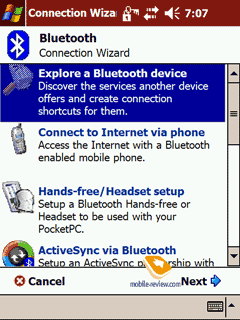 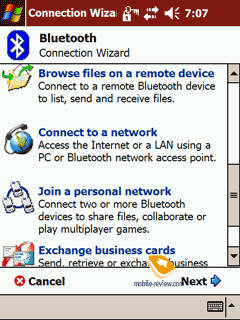
Bluetooth 1.2. As we've already said, the LOOX 710 has the standard WIDCOMM Bluetooth for Windows CE BT-PPC drivers (1.5.0 Build 1800 version), like in Asus A730 and the overwhelming majority of other Pocket PCs with Bluetooth. Automatically the existence of WIDCOMM drivers means the maximum functionality of Bluetooth. As it was expected everything ran without bugs and failures: the Internet connection via Sony Ericsson t630 and Motorola MPx220, File Transfer, Information Exchange, Serial Port, Dial-up networking server, audio gateway. The device supports several simultaneous Bluetooth connections.
Here is the full list of the profiles supported: BNEP, DUN-DT, FT-Client, GAP, File Transfer, Object Push, OPP Client, Point to Multipoint (PAN), FT-Server, LAN-DT, Point to Point (LAP), OPP Server, PAN-User, SDAP, SDP, SerialDevA, SerialDevB.
By the way, we mentioned the name WIDCOMM by force of habit. Recently the company Broadcom has absorbed WIDCOMM. So now we see the name Broadcom instead of WIDCOMM in drivers' properties. We want to believe, the company acquisition will tell upon the quality of the Bluetooth software, which has become the industry standard for Pocket PCs and desktop PCs powered by MS Windows.
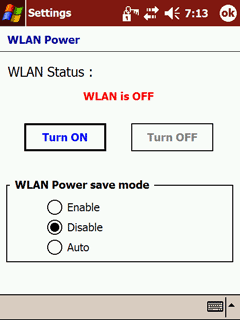
Wi-Fi.
The adapter worked good with a home access point within a 3-room flat: no rebukes, the sensitivity of the receiving antenna is high. The only thing that I didn't like is the program implementation of Wi-Fi: poor Wi-Fi manager settings, the lack WPA support (Wi-Fi Protected Access, at the moment this standard is considered safe, follow the link to learn more about it). There is only the support of a vulnerable encoding standard WEP 128 bit.
The utility E2C controls Wi-Fi settings. You can create a profile for only one wireless network, the scanner doesn't recognize networks with a latent SSID, there are specific problems for entering a WEP-key. Well, as I've already said the settings are poor. The problem can be solved with some exterior Wi-Fi managers. Besides there is a professional version of E2C, but you should acquire it additionally.
In all, the problems with Wi-Fi don't seem to be dramatic, just install an exterior Wi-Fi manager. Put up with the software roughness, and the LOOX 710 will do for the use with the home access point. The WPA support might appear in upcoming software versions, probably by the commercial launch.
FS Pocket LOOX 710 can be used as an IP-phone in Wi-Fi networks. You can use a Bluetooth-headset or do perfectly without it (there is an extra dynamic).
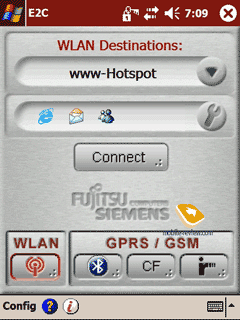 
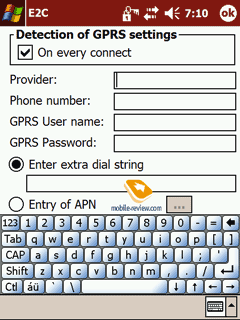 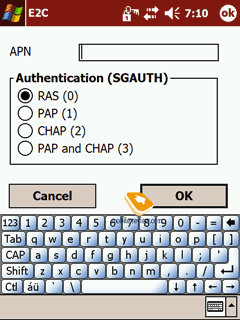
CONNECTMOBILITY-E2C. We'd rather pay special attention to the utility E2C. This application accounts for the Internet connection via any interface (Bluetooth, Wi-Fi, IrDA, CF-GPRS). The GPRS settings got very easy and facilitate the connection process for a beginner.
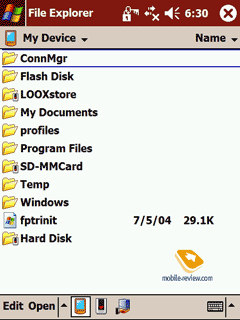
USB. The standard kit includes a combined USB-cable (USB Host and USB client). You can plug different USB-devices via the cradle or skipping it. For example - a camera, USB-flash or USB-keyboard. For other devices you'll need drivers for Pocket PC. The official Russian shipments include the russificator by Paragon, which will come with drivers for the Russian USB-keyboard. The device can be charged via the USB-cable, but the process lasts slower compared with the socket charging.
As for the device interfaces, the opportunities are ultimate. Two slots for extension - SD/MMC with the support of SDIO, Compact Flash Type II. Two wireless adapters - Bluetooth and Wi-Fi, which can work simultaneously. The infrared port allows controlling home electronics (it supports the consumer infrared standard - CIR). There is also a USB-host.
Battery
The LOOX 710 comes with the Li-Ion 1640 mAh battery onboard. I'd note, the handheld lasted much longer than the LOOX 720 in all our tests. In the MP3 mode (from the memory card, the lowest clock rate, the screen off) the battery got drained out after 18 hours 11 minutes. In the reading mode (page scrolling, the lowest backlight, the lowest clock rate) the LOOX 710 worked for 17 hours 36 minutes. Under the maximum load it was good for 3 hours 37 minutes. These are very good results at the record levels of HP iPaq rx3710, Asus A620Bt, Sony TH55!
Productivity
The user can access a little less than 63 MB of RAM from 64 MB and 30 MB of non-volatile flash-memory. This is a classical memory size for a mid-range PDA.
The LOOX 710 is powered by Intel XScale PXA272 416 MHz processor. The most PDA makers has already switched to this processor in top and mid range models, much rarely you will come across the processors by Samsung and TI. During tests we safely sped up the LOOX 710 up to 624 MHz, it performed unsteady work at it, but 520 MHz proved to be normal for most applications.
We used the SPB Benchmark package to test the productivity of the handheld. For this purpose we applied test results of mid range models with similar specs.
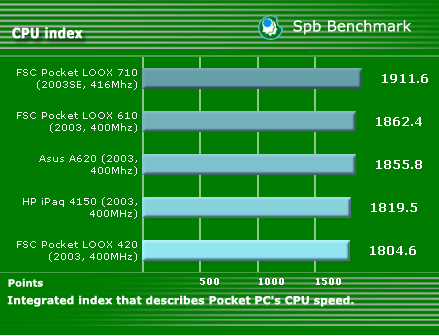
The LOOX 710 is slightly ahead with the CPU index. Here and then all models show similar results.
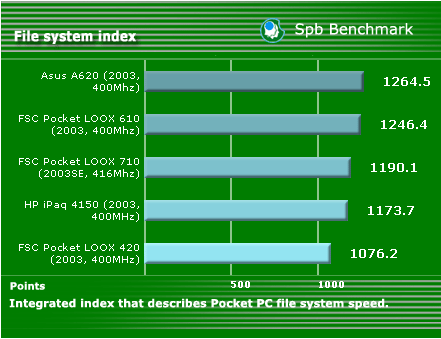
The file system index describes Pocket PC file system speed (read/record/move). This time again the results are almost identical.
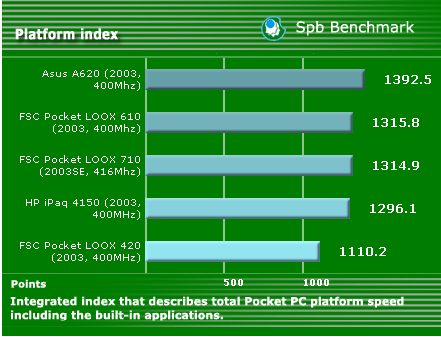
The platform index describes total Pocket PC platform speed including the built-in applications. Results are the same.
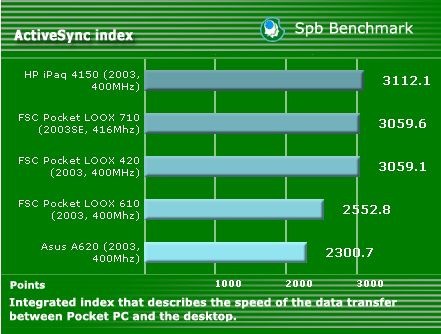
Synchronization speed..
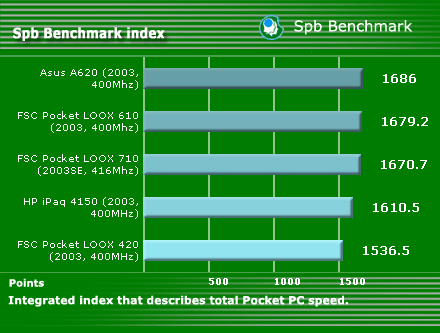
The integrated index describes total Pocket PC speed. In the whole, this index reflects the real position of the handheld in the speed aspect, but do remember the models are similar in their productivity, and we won't pick out one.
Let's see the results of tests in real applications. We tested video with the BetaPlayer 0.094, see the results in the table below. The speed is set in percents, the more it is, the faster the PDA is. Approximately 120% and higher - video is played smoothly without dropped frames, at 100% video can drop during active scenes. During tests the LOOX 710 was sped up to 528 MHz. A short resume - you can watch mpeg4 video on the LOOX 710 without any problems and you don't need to reconvert files.

To test graphics we ran tests of the PocketQuake game in the mute mode (turn the sound off by nosound 1 console command) leaving other settings unchanged. The results are close to those of the leader. At 520 MHz the handheld soared to the first rank. However at 624 MHz or higher it worked unsteadily, so we haven't tested the handheld in this mode.

I forgot to mention, you can choose the processor frequency rate of set the auto mode:
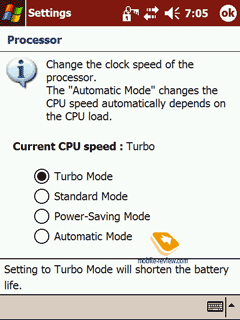
Software
The handheld is powered by the operating system Windows Mobile 2003 Second Edition. You can learn more about its opportunities in the respective review published on our site. Well, here we deal with non-standard built-in applications.
E2C. We wrote about it in the chapter "Interface".
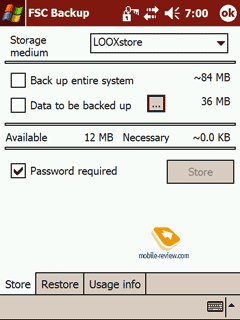 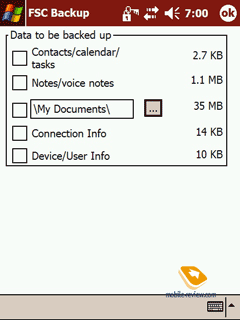
FSC Backup. The program executes a backup. It's possible to choose whether to copy all the data from RAM or just favorite files. As for the shortcomings, you can't run the application on the schedule, and there isn't an automatic data backup when the batter is low.
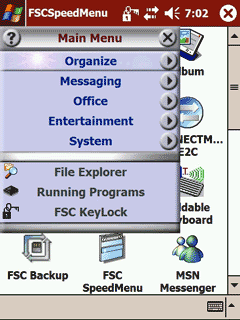
FSC Speed Menu. It's an analog of Start button, but it is much flexible and advanced, that is nice - you can easily adjust it for your own needs by adding necessary applications and folders.
Impressions and conclusion
FS Pocket LOOX 710 marks the upper level for the mid price range (maximum interfaces involved, long battery life, thought-out ergonomics, good design). The lowest price for the device makes up $470-480. Dell X50 520 MHz and the hit of the last season HP iPaq 2210 are listed for about $330. Another direct rival HP iPaq hx2400 costs some $450. Given this we can say that the LOOX 710 is overpriced. The device deserves more attention, when the price falls to $400-410.
Description:
- Class: Middle-End
- Position in the line: below Pocket LOOX 720
- Rival models: Dell X50 520 MHz, HP iPaq hx2400
- Operating system: Windows Mobile 2003 Second Edition
- Processor: Intel XScale PXA272 416 MHz
- RAM: 64 MB (62.74 MB available to the user)
- LOOXstore (flash-memory available): 30.6 4 MB
- Connectivity: SD/MMC slot (SDIO support), Compact Flash Type II, IrDA, Bluetooth 1.2 Power class 2, IEEE 802.11b (Wi-Fi, chip maker - Texas Instruments), USB (1.1 slave, 1.1 host)
- Extra dynamic for IP-telephony via Wi-Fi
- Screen: 3.5", 320x40 pixels, 65K colors
- Battery: removable Li-Ion 1640 mAh. Battery life claimed: 12 hours active, 15 days standby. Backup battery life - 30 minutes
- Dimensions: 122x72x16.1 mm
- Weight: 180 g.
We are grateful to RRC Focus Distribution for the provided devices.
Anton Kotov (anton.kotov@mobile-review.com)
Translated by Anja Rytchkova (anja.rytchkova@mobile-review.com)
Published - 1 February 2005
Have something to add?! Write us... eldar@mobile-review.com
|
News:
[ 31-07 16:21 ]Sir Jony Ive: Apple Isn't In It For The Money
[ 31-07 13:34 ]Video: Nokia Designer Interviews
[ 31-07 13:10 ]RIM To Layoff 3,000 More Employees
[ 30-07 20:59 ]Video: iPhone 5 Housing Shown Off
[ 30-07 19:12 ]Android Fortunes Decline In U.S.
[ 25-07 16:18 ]Why Apple Is Suing Samsung?
[ 25-07 15:53 ]A Few Choice Quotes About Apple ... By Samsung
[ 23-07 20:25 ]Russian iOS Hacker Calls It A Day
[ 23-07 17:40 ]Video: It's Still Not Out, But Galaxy Note 10.1 Gets An Ad
[ 19-07 19:10 ]Another Loss For Nokia: $1 Billion Down In Q2
[ 19-07 17:22 ]British Judge Orders Apple To Run Ads Saying Samsung Did Not Copy Them
[ 19-07 16:57 ]iPhone 5 To Feature Nano-SIM Cards
[ 18-07 14:20 ]What The iPad Could Have Looked Like ...
[ 18-07 13:25 ]App Store Hack Is Still Going Strong Despite Apple's Best Efforts
[ 13-07 12:34 ]Infographic: The (Hypothetical) Sale Of RIM
[ 13-07 11:10 ]Video: iPhone Hacker Makes In-App Purchases Free
[ 12-07 19:50 ]iPhone 5 Images Leak Again
[ 12-07 17:51 ]Android Takes 50%+ Of U.S. And Europe
[ 11-07 16:02 ]Apple Involved In 60% Of Patent Suits
[ 11-07 13:14 ]Video: Kindle Fire Gets A Jelly Bean
Subscribe
|


























